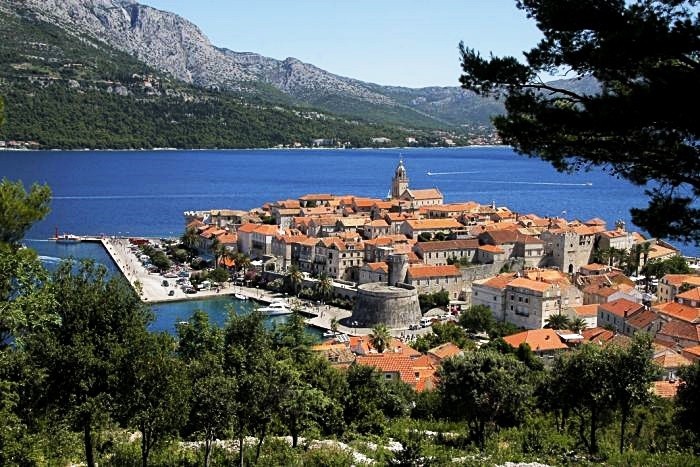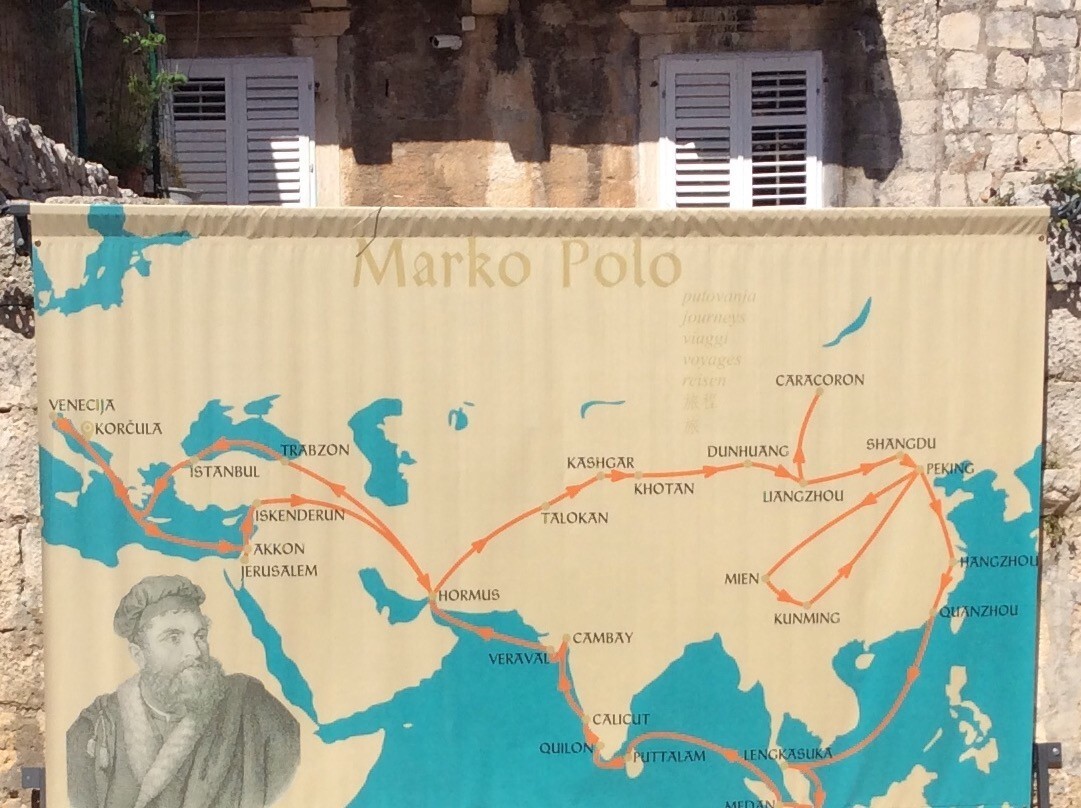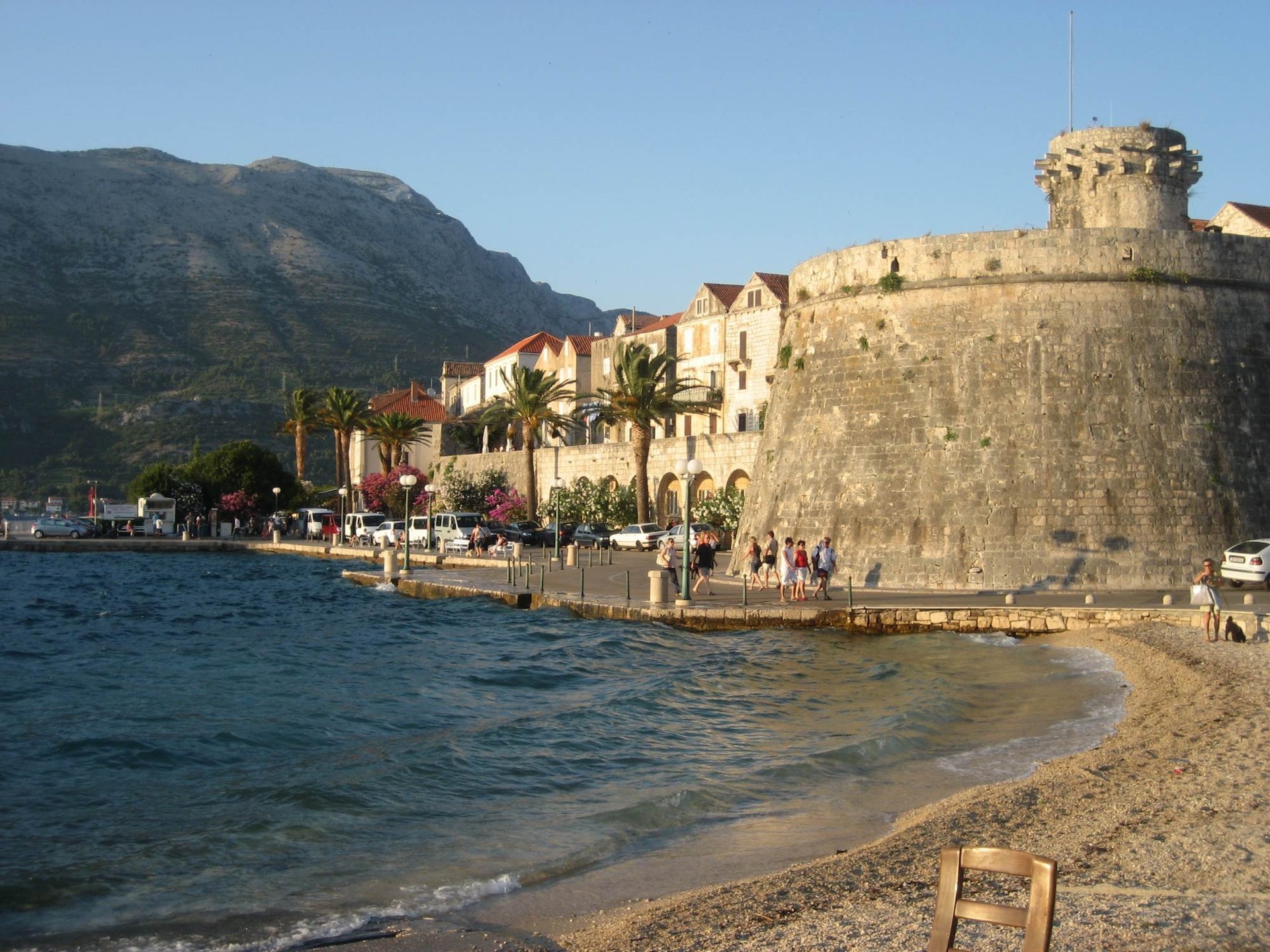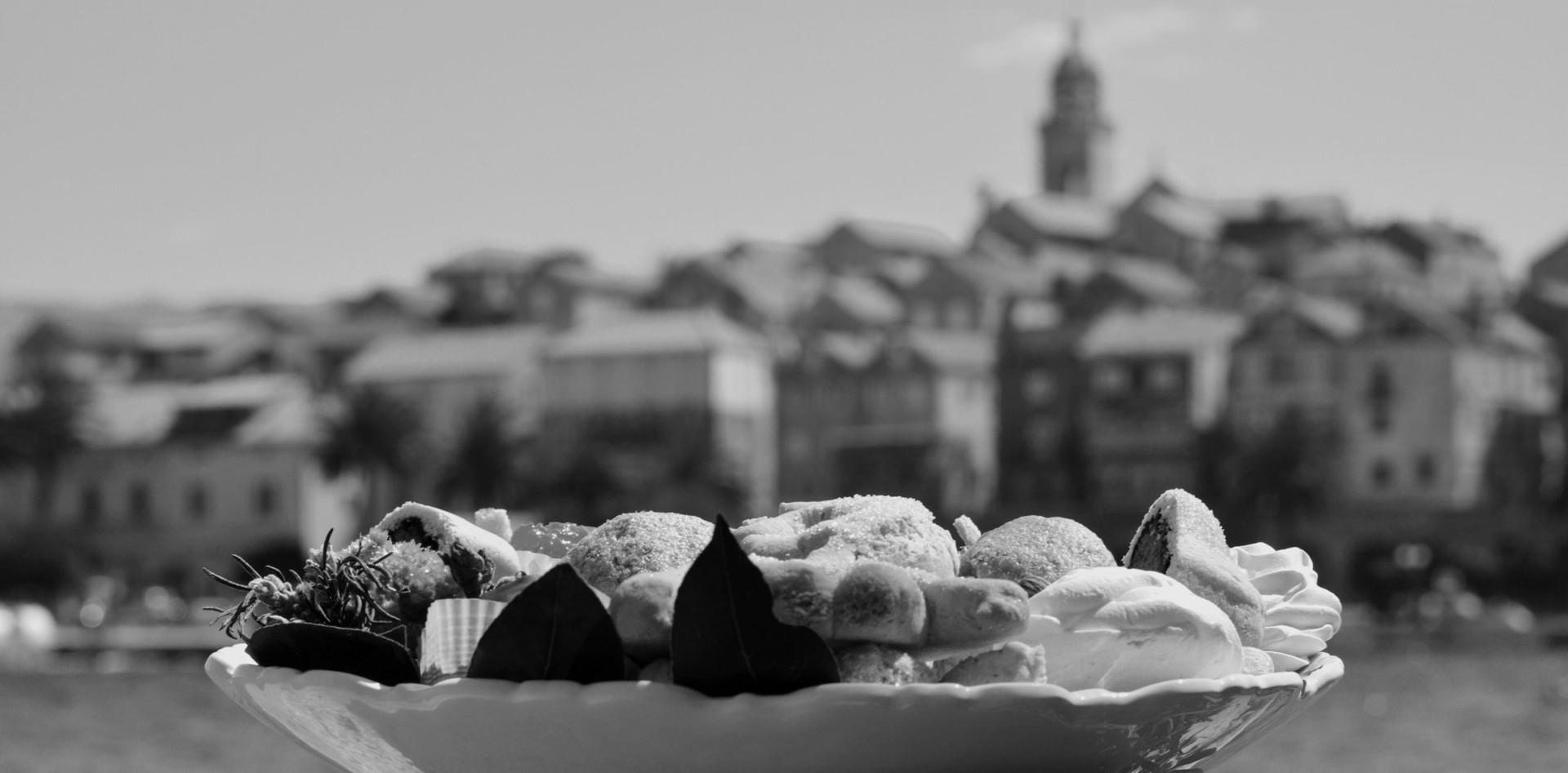Korcula, a must-see town in Croatia!
The island of Korcula
You cannot visit Croatia without visiting the Korcula region. Why? You may think it is similar to other regions since it has many vineyards, olive groves, small villages and communities. The first Greek settlers called it 'Korkyra Melaina' (Black Korcula) for its many forests.
The structure and architecture of the Korcula region

What makes the region different is an awesome town on the island, also called Korcula, which is its main town and has lots of wonderful, marble streets and impressive buildings. The rugged coastline is full of quiet beaches and small coves, whilst more flat, the northern coastline has lots of natural ports. Korcula's tradition is still alive with ancient religious ceremonies still taking place and folk dance and music performances which entertain a growing number of tourists. I have to say that Korcula is famous for its wine, especially the dessert wine made with grapes from the Lumbarda region.
The island offers two major ports: Korcula and Vela Luka, which is in the west of the island. All ferries from Jadrolinija, Split, which go to Dubrovnik stop at Korcula port. Jadrolinija offers a daily passenger boat from June to September between Split and Vela Luka which stops in Hvar (the island north of Korcula). There is also a fast boat, the Krilo, which travels between Split and Korcula with a stop in Hvar. It leaves daily in the summer and three to five times weekly from October to May. It also sets sail from Prigradica near Blato. For more information, visit Marco Polo Tours in Korcula, or Split Tours in Split.
In the afternoon, there is a ferry where you can take your car which goes between Split and Vela Luka (stops at Hvar almost every day) but you cannot drive your car on Hvar. There are six daily buses that go from Korcula to Vela Luka but these buses go less often at the weekends. If you want to travel to Orebic, there is a passenger boat which will leave from next to the Hotel Ijrcula, just below the towers of the city of Korcula.
The city of Korcula

Finally and obviously, I have to tell you about the city of Korcula, one of the hidden gems of Croatia. The marble streets are lined with Renaissance and Gothic buildings, and the amazing urban planning of the narrow streets which branch off the main street like a fish bone were intelligently designed to provide citizens with sheltered and comfortable accommodation. The western streets were built in a straight line to open up the city to the refreshing Maestral summer (strong and steady wind from the west), while the eastern streets were designed as curves in order to reduce the harshness of the Bura winter (cold wind from the north east).
The city boasts a great port, aligned with impressive round towers and beautiful red-tiled houses. It leaves you speechless as it is so well designed and made of incredible material. Everywhere you look you will see art. I felt momentarily transported to Venice but without the decadent air that sometimes surrounds the Italian city.
Palm trees swaying in the wind are everywhere and there are beaches that are within walking distance of the city. However, although the island is a favorite destination for families, you might want to leave the city and visit some more secluded beaches which are more peaceful. If you're on vacation, you will not want to feel like you are in Matalascañas. The city of Korcula is the best starting point to go to Lumbarda, the isle of Badija, the city of Orebic on the Peljesac peninsula and the isle of Mljet.
Normally, the big car ferry from Jadrolinija usually docks beneath the walls of Korcula's old town on the eastern pier. If it is too windy, the ferry docks on the western quay in front of Hotel Korcula and the tourist office. The passenger boats from Orebic will also dock on the western pier. The bus station is south of the city, past the marina, on the way to the big hotels.
Almost everyone goes to the Orebic beaches, yet the waters around the city are also suitable for swimming. There is a small cove next to the large Governor's Gate, and rocky beaches around the hotels and around the Sveti Nikole promenade southwest of the old city.
A little history

Although documents indicate that a walled city existed on this site in the 13th century, the current city of Korcula was built in the 15th century. Its construction coincided with the apogee of stone carving skills on the island, lending the buildings and streets and distinctive style. In the sixteenth century, carvers added decorative flourishes such as ornate columns and coats of arms on the facades of buildings, giving a Renaissance look to the original Gothic structures.
In later centuries as the threat of invasion diminished, people began to build houses outside the walls, south of the ancient city. The narrow streets and stone houses of the "new" suburb attracted merchants and craftsmen; even today, you will find most of this commercial activity here.
You should take a closer look at the walls and towers that are really impressive when you come via boat to the town. On the western harbour, the Tower of the West Sea Gate has an inscription in Latin from 1592 which says that Korcula was founded after the fall of Troy. Nearby are the Large Governor's Tower (1483) and the smaller Governor's tower (1449), which protected the harbor and the Governor's Palace, which were next to the City Hall.
The entrance to the ancient city land is through the Veliki Revelin Tower, through the south door. It is decorated with coats of arms of the Doge of Venice and the Governors of Korcula. Originally, there was a wooden drawbridge but it was replaced by wide stone steps to provide a greater first appearance. The only surviving stretch of walls extends west of this tower.
Tourist destinations

- The Trg Svetog Marka is interesting to see, which is where the magnificent Cathedral of San Marcos stands.
- The Abbey of San Marcos is also worth seeing in the abbey palace, next to the cathedral. The entrance is decorated with a collection of icons, and the dalmatian art room has an excellent collection of paintings.
- The City Museum is in the Gabriellis Palace, opposite the Sanctuary. The history and culture of Korcula begins with a stone plaque commemorating the former Greek presence on the island. The collection of stone carvings illustrates the development of this art with sculptures and artisans tools and the Sailing Room shows tools and models from local boats. There is also an area dedicated to archaeology with prehistoric objects and an art collection of prehistoric furniture, textiles and portraits.
- Before leaving the square, you must take a look at the wonderfully decorated Palace Arneri, which is next to the museum. The building borders a narrow street of the same name.
- It is said that Marco Polo was born in Korcula in 1254. You can actually climb up the tower of his supposed house and it hardly costs anything!
- There is also a 'Icon Museum'. It is not exactly a museum, but it has some interesting Byzantine icons painted on wood, on gold backgrounds, and on ritual objects. Visitors of the museum are rewarded with being able to visit the wonderful, ancient and nearby church of 'All Saints'.
- In the summer season, water taxis wait at the Jadrolinija dock for passengers interested in visiting the different points of the island and to visit the isle of Badija, where there is a Franciscan monastery from the 15th century and a nudist beach.
- Bicycles can be rented from Kantun Tours and motorcycles or boats from Rentaire. For the best beach activities, you must go to Orebic.
- If you were curious, you might like to know that Korcula celebrates Easter with a great fanfare. Starting with Palm Sunday, the week before Easter is dedicated to ceremonies and processions organized by the local religious neighbourhoods who dress up in traditional costumes. Citizens sing songs and medieval hymns, Bible passages are read and the city gates are blessed. The most solemn processions are held on Good Friday, when members of all the neighbourhoods parade through the streets. The tourist office schedules events during this period, but when dealing with religious celebrations, photos are not normally allowed.
Camping and hostels
Camp sites
Where you stay depends on how much money you have, starting with the basics, there is lots of large and small camping sites. The largest is the Autocamp Kalac and is located in a great location, in a dense pine forest near the beach, behind the Hotel Bon Repos.
About 10 km west of the city, near Racisce, there are three smaller camps which are more private and less crowded, with quieter beaches. They are all open from June to mid-September and affordable, with a shop on site and keeping your car there is included in the price. They are called Oskorusica Kamp, Kamp Kamp Tri Zala and Vrbovica.
Hostels
There is also the Onelove Hostel which is led by South African staff and a Croatian hostel which is a bit more luxurious.
Hotels

The hotels of Korcula are high rising and full of toursits, although the hotels listed below are not all bad.
Firstly, we have the Hotel Bon Repos on the way out of the city, on the road to Lumbarda. This hotel has pretty gardens and a large pool overlooking a small beach. Although you might find it too big, the rooms are quite comfortable.
The Park Hotel is at first sight a concrete monstrosity with no architectural wonder but has its own beach and many rooms have balconies and sea views.
The Liburna Hotel has a pool, tennis courts and opportunities for windsurfing on a nearby beach, but the rooms are quite boring.
The Hotel Korcula on the western harbour, the most charismatic hotel, boasts a large terrace where you can enjoy a coffee and take in the view. The rooms are standard, of different sizes but try to get one overlooking the sea. Since there is no elevator, you will have to carry your luggage up the stairs.
Residencies
Those who avoid the big hotels will benefit from a more personal experience during their stay. Atlas Travel Agency and Marko Polo Tours provide rooms in private residencies, but you should also check out these residencies:
There is the Villa De Polo in the residential district that is close to the old town and only a 100 meters from the bus station, this guest house offers four modern and clean rooms, some with sea views. One night stays are added a surcharge of 30%.
If you stay at the Pension Hajduk, 2 km from the city on the road to Lumbarda, you will receive a warm welcome, air conditioning, a TV and even a swimming pool. To get there on foot, pass the Hotel Marko Polo and continue for around 1 km; after the fire station, it is on the right. The hotel restaurant is also worth visiting.
Other nearby resedencies are similarly priced; The Perucic which has stunning balconies, and the cosy Ojdanic. The owner of the latter, Ratko Ojdanic, also has a water taxi and runs fishing trips around the island.
Restaurants, bars, terraces and specialties

And of course I wouldn't forget to mention the best places to eat...
- The Cukarin: You have to try the Korcula cupcakes: elcukarini (a sweet bun), elcjjun (walnut cake), elamareta (a round rütelito made of rich almond) and elharubi (carob bean muffin). I was surprised to see long lines to eat them hot rather than cold.
- Fresh is just across from the bus station, Fresh is fabulous for fruit smoothies at breakfast, wraps at lunchtime, or beers and cocktails in the evening. It's the same as the Fresh in Dubrovnik.
- The Buffet-Pizzeria Doris serve simple but delicious dishes in the interior dining room or on the shaded terrace. The dish of grilled vegetables is delicious.
- The Planjak serves mixed grills and some authentic Balkan dishes on a shaded terrace. A paradise for carnivores.
- The Konoba Marinero is in the heart of the medieval Old Town. This family run restuarant lives up to its name. The children go fishing and catch the fish whilst the parents prepare different traditional recipes.
- The Konoba Maslina is worth the steep walk for authentic Korcula home cooking. It specialises in various bean soups. It is on the road to Lumbarda, at about 1 km past the Marko Polo Hotel, but you can request a transfer back and forth to the city.
- The Gradski Podrum is located at the crossing of the south gate, this restaurant serves Korcula style fish (served with boiled potatoes and tomato sauce). The pasta dishes and seafood are also delicious.
- The Cocktail Bar Massimo is located in a tower, which can only be accessed by a ladder. You can also enjoy wonderful views of the cathedral.
- The Tramonto is a terrace bar with fantastic sunsets, where you can enjoy one of its many cocktails. It is popular with locals, tourists and boat owners. The music is quiet and the atmosphere is relaxed.
- Dos Locos, the wildest bar in the city (as the name suggests) is where the younger generations usually hang out since it has its music full blast and shows music videos projected on the side of the building. It is behind the bus station.
Dances
How to watch them?
In summer, nobody will escape watching the amazing sword dances, 'the Moreíka' which is held at 21. 00 on Mondays and Thursdays of July and August by the entrance of the old town.
Tickets are a little expensive and can be purchased on site or at travel agencies on the island. If you can get manage to get transport there, Kumpanija dances in the villages of Pupnat, Smokvica, Blato and Cara are a great night out, but there are no buses to take you there.
For information on travelling to and around the city of Korcula, Jadrolinija tourist office is around 25m below the western port.
Usually, there are also regular Kumpanija dances across the island in Pupnat, Smokvica, Blato and Cara. This performance involves the "fight" between two rival armies and ends with the deployment of a huge flag. The show is accompanied with music from a local instrument called the 'elmisnice' (a kind of bagpipe) and drums.
The story of the dance

And like I said, to close the article, I will tell you some more about the sword dances.
One of the most diverse traditions of the island is the sword dance, which has been held in Korcula since the 15th century. Although, it probably originates from Spain, Korcula is now the only place where this tradition remains. The dance tells the story of two kings-the white king (dressed in red) and the black king who are fighting over a princess kidnapped by the black king. In the spoken introduction, the princess declares her love to the white king and the black king will not give it up. The two armies draw their swords and start to "fight", with the choreographed dance accompanied with a brass band... it is out of this world. Locals also dance in the show held in front of the south gate. Although traditionally, it was only performed in the city of Korcula on July 29, today it is shown on Monday and Thursday afternoons in July and August (sometimes also in June and September).
I recommend watching it, 100 percent.
Until next time!
Photo gallery
Content available in other languages
Want to have your own Erasmus blog?
If you are experiencing living abroad, you're an avid traveller or want to promote the city where you live... create your own blog and share your adventures!
I want to create my Erasmus blog! →











Comments (0 comments)